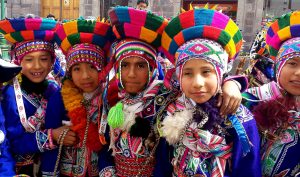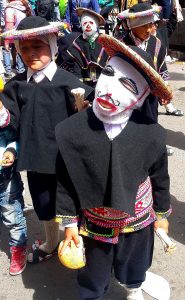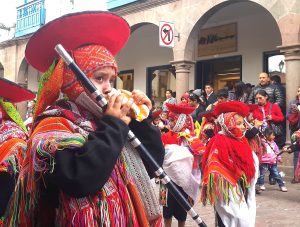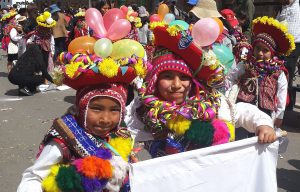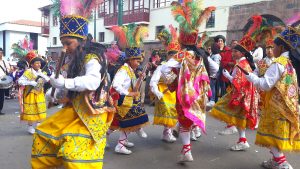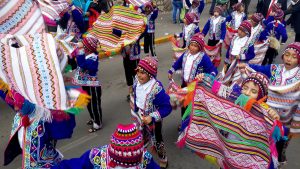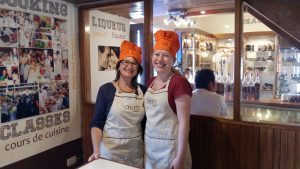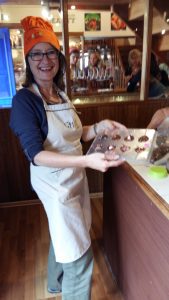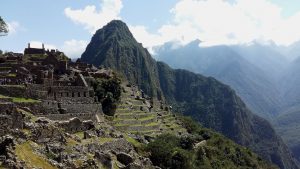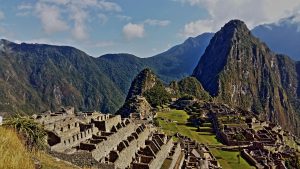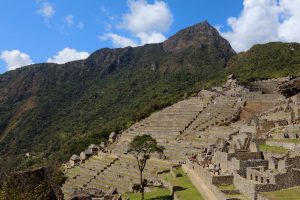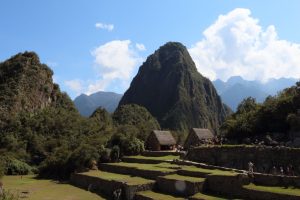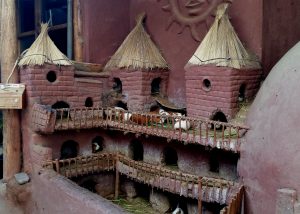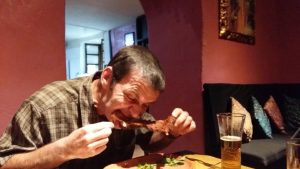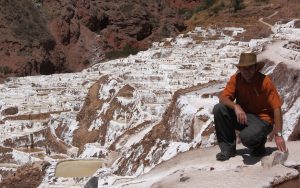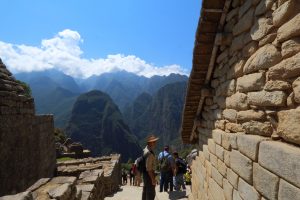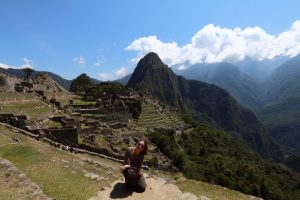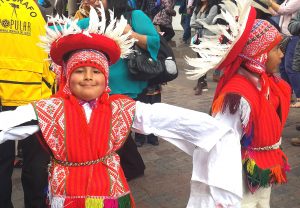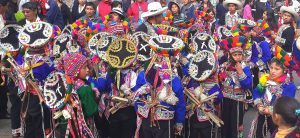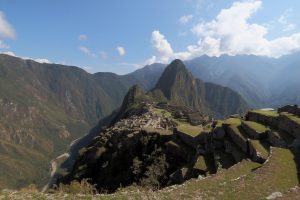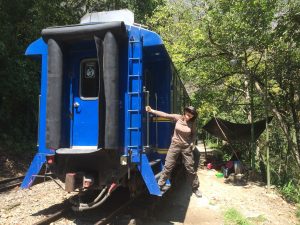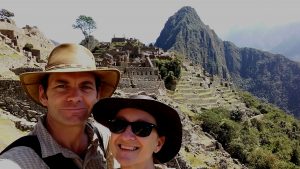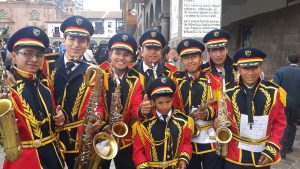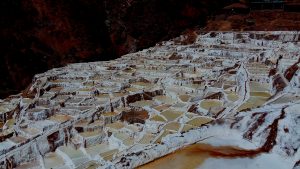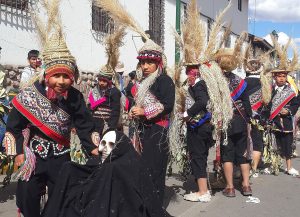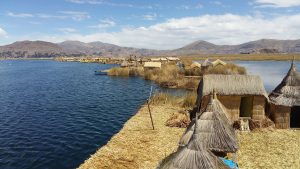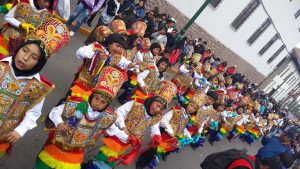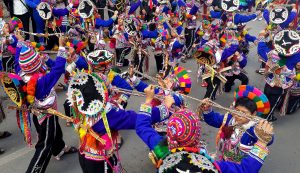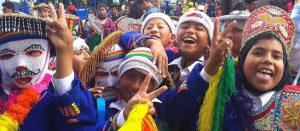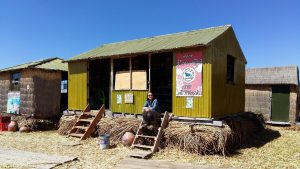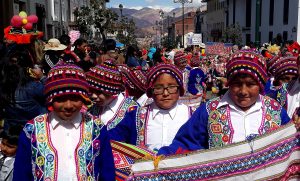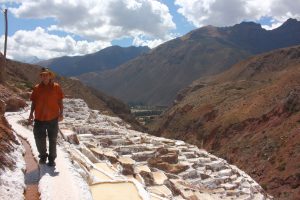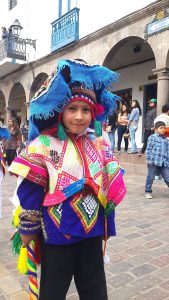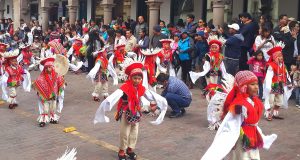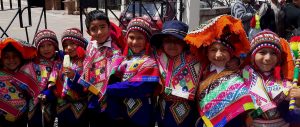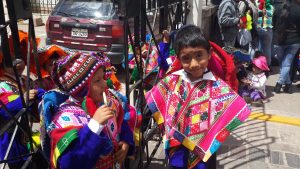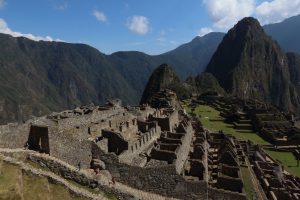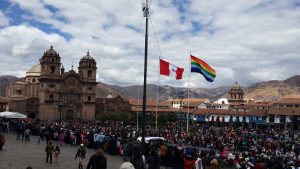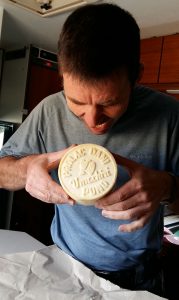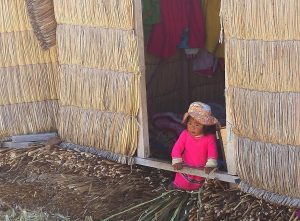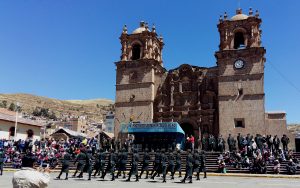Peru is a new country for us. We cross the border from Bolivia on the shore of Lake Titicaca near Copacabana and perhaps unsurprisingly, the Peru-bit of Lake Titicaca looks remarkably similar to the Bolivia-bit of Lake Titicaca! We’re heading first to Puno on the north-west side of the Lake then on to… well… errrm… we do have a plan, honest we do! We’ll let you know when it’s safe to do so (or to be more frank, when we have made up our minds and have a clue) 🙂 So much to see and do in Peru.
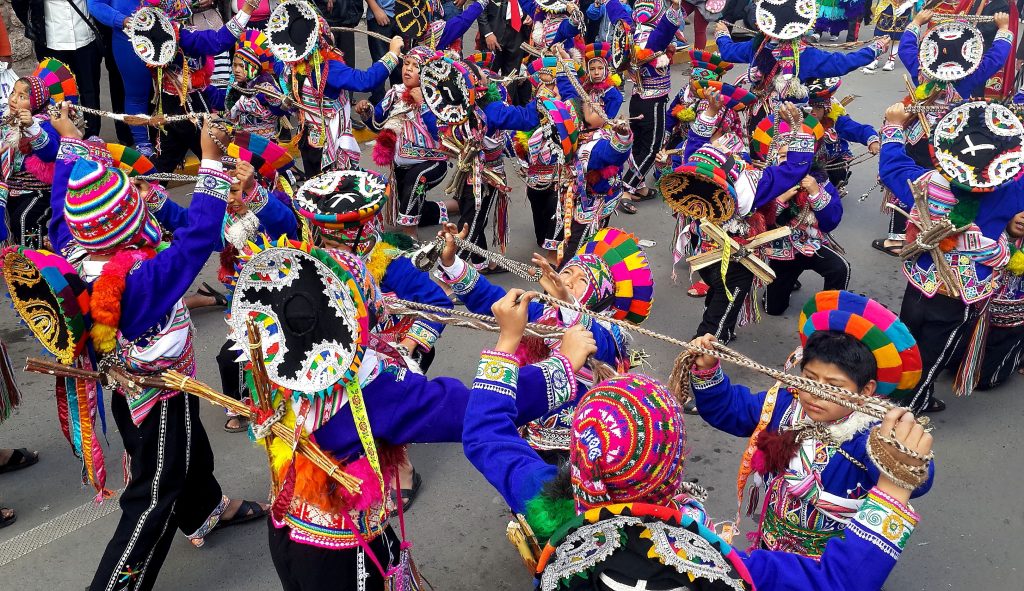
So as we were saying… there is little difference between the Bolivian and the Peruvian sides of Lake Titicaca, at least that is the case for a while. But as you drive north up the western shore, the snow-capped high peaks of the Bolivian Cordillera Real drift into the far distance and the Peruvian background takes shape around the Lake. The Peruvian Titicaca skyline is not unattractive, but it’s less remarkable and less dramatic than the Bolivian skyline. Although we sit on the altiplano at around 3,700m, the Peruvian scenery could easily be British: Scotland or the Lake District maybe.
We arrive in Puno to witness some kind of military event in town, with parades of troops marching before senior officers and political leaders perched on a dais in the town square. Not sure about the meaning of all this, but we took a couple of snaps and moved on. Puno is more famously known as the base from which the Uros floating reed islands can be visited and we are looking forward to this. The archetypal Titicaca images of colourful locals fishing from curly-ended long-boats made of reeds, are all taken near here. However, on arrival in Puno we realise that Marcus has picked-up a nasty stomach bug so rather than doing a wild-camp, we park-up in a civilised camp-site for the several days that it takes him to regain his strength. Rather unpleasant, but it’s the first that either of us has suffered after over 2½ years on the road, so it’s not a bad record.

Peru? Or Scotland?
If there is a plus-side to this impromptu sojourn, it is the phenomenal internet speed available at the campsite. Wowser. This is by far the best that we have had in the whole of South America so far! We waste no time in updating all our digital mapping, down-loading all the Windows updates for our laptops and, here’s the rare treat… down-loading a bit of t.v. to watch on cold Andean nights (we’re liking West Wing at the moment).
Once the poorly-boy was fit to take to the Lake, we take a boat out to see the Uros floating reed islands. Now… we have over our years of travel visited some of the most cheesy of cheesiest touristy attractions that the world has to offer, but the Uros Islands set a new world standard of tourism cheesiness. In the spirit of the current Río 2016 theme, we could comfortably describe the Uros as the Olympic champions… the Usain Bolt… of cheesy-tourism. If medals were awarded for touristy-cheese, then the Uros would be up there on the podium, standing proudly to attention as the Peruvian national anthem is played. Okay… you get the idea!
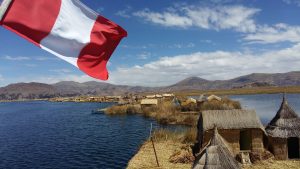 So here’s a quick canter through the morning’s events. After a 20min boat ride from Puno pier, we arrive at ‘Island Exhibit No. 1’ where a few colourfully dressed ladies await their next influx of tat-retail victims. After a cursory introduction to the tiny island, they waste no time in delivering the heavy pressure for visitors to purchase ‘local crafts’, few of which appear to have been crafted locally and most of which sport a suspiciously ‘factory like’ level of consistency in their construction. Soon we are ushered onto a different boat for transfer to ‘Island Exhibit No. 2’, the restaurant island. Here we find an ‘opportunity’ to purchase yet more tat and some refreshments, before being shuttled back to Puno. As we depart the island, three of the aforesaid colourfully clad ladies stand at the shore to sing us a farewell tune… that well-known Peruvian folk-song ‘Row, row, row y’r boat…’! If they had been offered a free luxury yacht to do so, they really could not have looked more despondent, or sounded less tuneful and enthusiastic in their work.
So here’s a quick canter through the morning’s events. After a 20min boat ride from Puno pier, we arrive at ‘Island Exhibit No. 1’ where a few colourfully dressed ladies await their next influx of tat-retail victims. After a cursory introduction to the tiny island, they waste no time in delivering the heavy pressure for visitors to purchase ‘local crafts’, few of which appear to have been crafted locally and most of which sport a suspiciously ‘factory like’ level of consistency in their construction. Soon we are ushered onto a different boat for transfer to ‘Island Exhibit No. 2’, the restaurant island. Here we find an ‘opportunity’ to purchase yet more tat and some refreshments, before being shuttled back to Puno. As we depart the island, three of the aforesaid colourfully clad ladies stand at the shore to sing us a farewell tune… that well-known Peruvian folk-song ‘Row, row, row y’r boat…’! If they had been offered a free luxury yacht to do so, they really could not have looked more despondent, or sounded less tuneful and enthusiastic in their work.
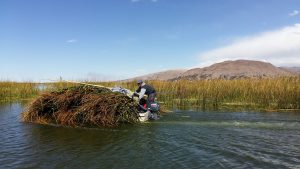
New reeds arriving
Okay, that maybe a slightly harsh summary of the half-day trip, but it’s not far off. Somewhere out amongst these islands are genuine communities surviving on fishing, but visitors see none of the authentic side of this place. The Uros are made up of many individual floating reed islands, each around 200-300 square metres. This makes it impossible for visitors to make any kind of independent journey to see the islands or to wander far from the tat-stalls once there. “But it’s a tourism thing…” we hear you mutter in exasperation… “what on earth did you expect?” Well that’s a good point. Understandably, most ordinary people around the world would be reluctant when going about their daily business, to have hundreds of tourists traipsing daily through their front garden. Given the extremely confined spaces in which these people live, the level of intrusion would be destructive if tourists were allowed to roam uncontrolled. The issue is probably that for us, being used to a very free mode of travel in our Cuthbert, we are so unused to this level of controlled tourism and it felt strange to us.
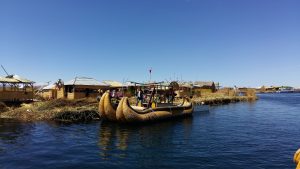 We’ve painted a fairly negative picture of the experience but there were of course some interesting bits too. There is the sensation of stepping off the boat onto the surface of the reed island. They’re made from layer upon layer of reeds harvested from around the lake-shore and you sink gently into the softness as you walk around (whilst we were there, boats arrived stacked high with new bundles of reeds to replenish the flooring). We saw how the people carefully retain constant fires for cooking and how they keep tiny trout-farms off the side of the island. The huts on the island appear on first glance to be made of reeds, and the older round-shaped huts still are. However, the newer square-shaped huts are now mostly frames of corrugated iron, clad with reed panels; partly for warmth, but also to appear more authentic.
We’ve painted a fairly negative picture of the experience but there were of course some interesting bits too. There is the sensation of stepping off the boat onto the surface of the reed island. They’re made from layer upon layer of reeds harvested from around the lake-shore and you sink gently into the softness as you walk around (whilst we were there, boats arrived stacked high with new bundles of reeds to replenish the flooring). We saw how the people carefully retain constant fires for cooking and how they keep tiny trout-farms off the side of the island. The huts on the island appear on first glance to be made of reeds, and the older round-shaped huts still are. However, the newer square-shaped huts are now mostly frames of corrugated iron, clad with reed panels; partly for warmth, but also to appear more authentic.
At the end of the day, it’s a fun, if less than authentic cultural experience and we are glad that we went. The boat-ride out and around the islands was scenic and a bit of an adventure, particularly as we went with Peruvian visitors on the ‘collectivo’ boat rather than a Westerners’ ‘Gringo tour’. Our tourism-buck helps these communities earn a far better living than they would otherwise get from fishing and we are happy to contribute to this, but if they want visitors to leave with a more favourable impression, they could try adding a small element of authenticity and a little enthusiasm to their performance 🙂
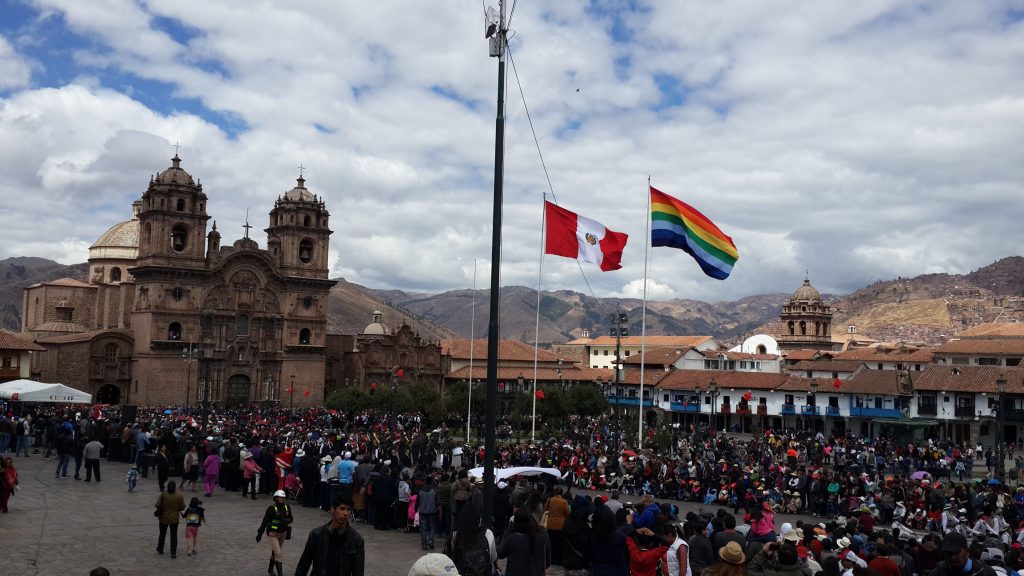 So after the Uros and some interesting nearby ruins at Sillustani, we push on north-wards into Peru. We are now getting a bit excited… in just over a couple of weeks our good friends Karen and Jimmy are flying out from UK for a holiday in Peru and we are meeting them in Cusco. We’re sooo looking forward to this and (thanks to their great forward planning and organisational skills) we have lots of exciting things on the agenda with them. But we’ve got just over two weeks to kill before they arrive, so what about that ‘plan’ that we promised? Well… we formed a tenuous plan to head down to Arequipa and the much visited Colca Canyon area. Unfortunately, on the day we were leaving Puno, the Arequipa area suffered a severe earthquake causing the access roads to be blocked and more tragically, killing 10 people. This is clearly not the most appropriate time to tour that area and instead we head directly to Cusco. The plan now is to check-out the town and the Sacred Valley area before Jimmy and Karen arrive.
So after the Uros and some interesting nearby ruins at Sillustani, we push on north-wards into Peru. We are now getting a bit excited… in just over a couple of weeks our good friends Karen and Jimmy are flying out from UK for a holiday in Peru and we are meeting them in Cusco. We’re sooo looking forward to this and (thanks to their great forward planning and organisational skills) we have lots of exciting things on the agenda with them. But we’ve got just over two weeks to kill before they arrive, so what about that ‘plan’ that we promised? Well… we formed a tenuous plan to head down to Arequipa and the much visited Colca Canyon area. Unfortunately, on the day we were leaving Puno, the Arequipa area suffered a severe earthquake causing the access roads to be blocked and more tragically, killing 10 people. This is clearly not the most appropriate time to tour that area and instead we head directly to Cusco. The plan now is to check-out the town and the Sacred Valley area before Jimmy and Karen arrive.
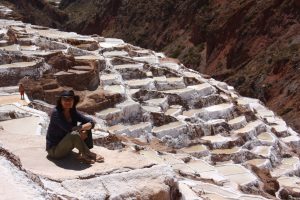 Arrival in Cusco and we find another fiesta taking place. Not sure whether we have an uncanny knack for unwittingly finding these random events or whether they are ubiquitous across this part of South America; I suspect the latter is more likely. Cusco did not have the spangled street-party that we found in Sucre, or the military march that we found in Puno, but a loooong afternoon procession of dancing kids. We realised after a while that it was curiously all little boys, aged between around 8 and 12 years old. Like many little boys of that age, they were not all wholly enthusiastic about dancing through the street in brightly coloured traditional outfits. What is it with ambitious parents of the world??? As with the famous soccer-mums of the western world, the less enthusiastic of these little boys were shuffling awkwardly, followed all the way through the town by red-faced mothers screaming wildly over the band-music “Juanito, baila, baila!!!” (dance, dance!).
Arrival in Cusco and we find another fiesta taking place. Not sure whether we have an uncanny knack for unwittingly finding these random events or whether they are ubiquitous across this part of South America; I suspect the latter is more likely. Cusco did not have the spangled street-party that we found in Sucre, or the military march that we found in Puno, but a loooong afternoon procession of dancing kids. We realised after a while that it was curiously all little boys, aged between around 8 and 12 years old. Like many little boys of that age, they were not all wholly enthusiastic about dancing through the street in brightly coloured traditional outfits. What is it with ambitious parents of the world??? As with the famous soccer-mums of the western world, the less enthusiastic of these little boys were shuffling awkwardly, followed all the way through the town by red-faced mothers screaming wildly over the band-music “Juanito, baila, baila!!!” (dance, dance!).
Cusco is a beautifully kept showcase city full of character, both Inca and colonial history and period architecture. Regular Cuthbert readers may recall that we raved about the city of Sucre in Bolivia, well this is Peru’s equivalent and with all due apologies to the good people of Sucre, this is even bigger and better! With the increased size and with tourism on a far greater scale, it arguably lacks some of Sucre’s intimacy and warmth, but it is nevertheless still one of the ‘top-ticks’ of South America. There are lots of narrow, cobbled streets stuffed to the brim with cheap and colourful tourist-tat for the back-packers and economy tourists. However, the many swanky hotels and stylish boutiques of expensive, high-end souvenirs are strong evidence that the opposite end of the tourism scale is here too (priciest seen so far: 4,000 Soles/£1,000 for an alpaca sweater!)
So there is Inca and colonial history and all that interesting stuff in Cusco, but there’s much else to do too. An advert for a chocolate course caught my eye. Not really Marcus’ thing, but never let it be said that I willingly decline any chocolate-related opportunity that presents itself to me. I turn-up to meet my co-student, Katie from England and the two of us have a great time with choco-maestro Miguel showing us the process, roasting and pummelling cocoa beans. We make a selection of yummy chocolatey things, but find the presentation-skills aspect not quite as easy as it looks! I am now, even more than ever, totally in awe of the skill of my friend Becky Taylor in UK, the chocolate-queen with her beautiful hand-made choccies (www.chocsaway.co.uk).
The general popularity of Cusco for tourism is reflected in the number of overlanding trucks parked-up in the Quita Lala campsite on the hillside above the town. On arrival here we find seven other trucks, five of which we knew from meetings at various stages on our way north and one of which we knew ‘electronically’ from the internet travellers’ chat-rooms, so it was a welcome reunion with lots of friendly faces here 🙂

Cuthbert reunited with his truck-chums in Cusco
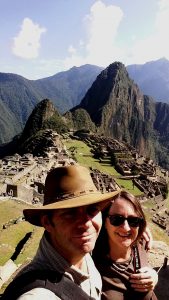 Whilst in Cusco we contemplate the ‘Whether to Machu Picchu?’ question. Uh? What question? Miss one of the world’s most famous tourist attractions? Well… there are indeed an increasing number of travellers who intentionally avoid Machu Picchu due to (allegedly) extortionate costs and unbearable crowds. Hmmm… decisions, decisions. Our instinct is that we really want to see it, and that our South American tour would not be complete without it. So… let’s give it a go.
Whilst in Cusco we contemplate the ‘Whether to Machu Picchu?’ question. Uh? What question? Miss one of the world’s most famous tourist attractions? Well… there are indeed an increasing number of travellers who intentionally avoid Machu Picchu due to (allegedly) extortionate costs and unbearable crowds. Hmmm… decisions, decisions. Our instinct is that we really want to see it, and that our South American tour would not be complete without it. So… let’s give it a go.
Getting to Machu Picchu can be done the easy/expensive way (by train) or, if you have the luxury of time and your own vehicle, the complicated/cheaper way. This involves some driving through stunningly scenic countryside and a lovely 2 hr (flat) walk down a beautiful winding valley, taking in views up to Machu Picchu from the side most visitors don’t get to see. We really enjoy the walk and decide to stay the night in a hotel in Aguas Calientes at the base of Machu Picchu mountain to give ourselves more time in the area. The entry to Machu Picchu is only around US$37 and we waited a total of less than 10 mins in queues. Not bad huh? In many western tourist attractions the queue is longer than that to get into the ladies’ loos! The ruins are very interesting and those Inca chaps certainly knew how to pick a spectacular location for their pads – it’s almost as if they had the 21st century ‘happy-snap’ selfie in mind when they built that place 🙂 All in all, a top-trip and we’re chuffed that we went.
So we head happily back to Cusco and on the way we see one of those pick-your-own guinea pig places. No, not a pet-shop, a restaurant! Just like in those seafood restaurants where you pick a lobster and have it grilled to order, here you study the pink Guinea Pig Palace and select your little furry chum for lunch 😛 Personally, I can’t face a meal where cute little Gus the Guinea Pig is staring up at me from the plate, but it’s really a delicacy here. Marcus had tried it a few days before so we didn’t stop to eat here, but we couldn’t resist the photo-opportunity.
- Guinea Pig Manor – choose your lunch
- Marcus tucking into little Gus
Only a few days now… looking forward to Jimmy & Karen’s imminent arrival for some hiking to Rainbow mountain, via-ferrata rock-climbing, sleeping on a cliff-face and zip-wiring! Can’t wait… 🙂
Link to next blog: Sleeping on a cliff-face Link to full South America Blog
Incas and Reeds Gallery
- New reeds arriving
- Cuthbert reunited with chums in Cusco
- Guinea Pig Manor – choose your lunch
- Marcus tucking into little Gus
- Peru? Or Scotland?
- Marching in Puno

